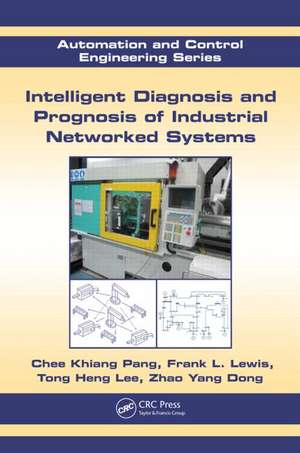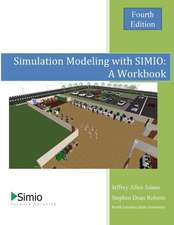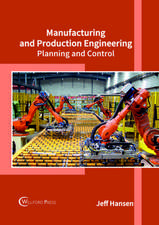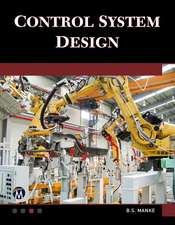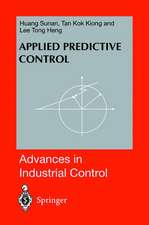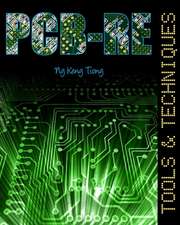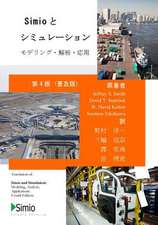Intelligent Diagnosis and Prognosis of Industrial Networked Systems: Automation and Control Engineering
Autor Chee Khiang Pang, Frank L. Lewis, Tong Heng Lee, Zhao Yang Dongen Limba Engleză Hardback – 22 iun 2011
Intelligent Diagnosis and Prognosis of Industrial Networked Systems proposes linear mathematical tool sets that can be applied to realistic engineering systems. The book offers an overview of the fundamentals of vectors, matrices, and linear systems theory required for intelligent diagnosis and prognosis of industrial networked systems. Building on this theory, it then develops automated mathematical machineries and formal decision software tools for real-world applications.
The book includes portable tool sets for many industrial applications, including:
- Forecasting machine tool wear in industrial cutting machines
- Reduction of sensors and features for industrial fault detection and isolation (FDI)
- Identification of critical resonant modes in mechatronic systems for system design of R&D
- Probabilistic small-signal stability in large-scale interconnected power systems
- Discrete event command and control for military applications
Din seria Automation and Control Engineering
-
 Preț: 386.02 lei
Preț: 386.02 lei - 20%
 Preț: 751.17 lei
Preț: 751.17 lei -
 Preț: 317.35 lei
Preț: 317.35 lei - 31%
 Preț: 433.47 lei
Preț: 433.47 lei - 18%
 Preț: 1330.48 lei
Preț: 1330.48 lei - 18%
 Preț: 1144.56 lei
Preț: 1144.56 lei - 15%
 Preț: 542.20 lei
Preț: 542.20 lei -
 Preț: 422.59 lei
Preț: 422.59 lei - 26%
 Preț: 1577.16 lei
Preț: 1577.16 lei - 15%
 Preț: 489.26 lei
Preț: 489.26 lei - 20%
 Preț: 618.36 lei
Preț: 618.36 lei - 8%
 Preț: 460.07 lei
Preț: 460.07 lei - 18%
 Preț: 1339.62 lei
Preț: 1339.62 lei - 26%
 Preț: 874.36 lei
Preț: 874.36 lei - 18%
 Preț: 1325.92 lei
Preț: 1325.92 lei - 26%
 Preț: 428.70 lei
Preț: 428.70 lei - 18%
 Preț: 1108.37 lei
Preț: 1108.37 lei - 15%
 Preț: 461.03 lei
Preț: 461.03 lei - 18%
 Preț: 1054.58 lei
Preț: 1054.58 lei - 31%
 Preț: 767.57 lei
Preț: 767.57 lei - 38%
 Preț: 331.87 lei
Preț: 331.87 lei - 38%
 Preț: 331.87 lei
Preț: 331.87 lei - 35%
 Preț: 408.36 lei
Preț: 408.36 lei - 18%
 Preț: 1229.15 lei
Preț: 1229.15 lei - 18%
 Preț: 1125.42 lei
Preț: 1125.42 lei - 26%
 Preț: 456.63 lei
Preț: 456.63 lei - 30%
 Preț: 931.61 lei
Preț: 931.61 lei - 18%
 Preț: 1668.41 lei
Preț: 1668.41 lei - 29%
 Preț: 1194.39 lei
Preț: 1194.39 lei - 27%
 Preț: 428.70 lei
Preț: 428.70 lei - 29%
 Preț: 1190.72 lei
Preț: 1190.72 lei - 9%
 Preț: 620.15 lei
Preț: 620.15 lei - 29%
 Preț: 1100.25 lei
Preț: 1100.25 lei - 18%
 Preț: 1344.22 lei
Preț: 1344.22 lei - 15%
 Preț: 456.50 lei
Preț: 456.50 lei - 18%
 Preț: 784.81 lei
Preț: 784.81 lei - 18%
 Preț: 1305.87 lei
Preț: 1305.87 lei - 18%
 Preț: 1223.61 lei
Preț: 1223.61 lei - 35%
 Preț: 408.36 lei
Preț: 408.36 lei
Preț: 207.71 lei
Preț vechi: 439.79 lei
-53% Nou
Puncte Express: 312
Preț estimativ în valută:
39.75€ • 41.35$ • 32.82£
39.75€ • 41.35$ • 32.82£
Carte tipărită la comandă
Livrare economică 14-28 aprilie
Preluare comenzi: 021 569.72.76
Specificații
ISBN-13: 9781439839331
ISBN-10: 1439839336
Pagini: 336
Ilustrații: 66 b/w images and 66 tables
Dimensiuni: 156 x 234 mm
Greutate: 0.59 kg
Ediția:New.
Editura: CRC Press
Colecția CRC Press
Seria Automation and Control Engineering
ISBN-10: 1439839336
Pagini: 336
Ilustrații: 66 b/w images and 66 tables
Dimensiuni: 156 x 234 mm
Greutate: 0.59 kg
Ediția:New.
Editura: CRC Press
Colecția CRC Press
Seria Automation and Control Engineering
Public țintă
Postgraduate students and researchers in control engineering, as well as industrial engineers in systems reliability.Cuprins
Introduction. Vectors, Matrices, and Linear Systems. Modal Parametric Identification (MPI). Dominant Feature Identification (DFI). Probabilistic Small Signal Stability Assessment. Discrete Event Command and Control. Future Challenges. References. Index.
Notă biografică
Chee Khiang Pang is an Assistant Professor in the Department of Electrical and Computer Engineering at National University of Singapore.
Frank L. Lewis is a Professional Engineer and Head of Advanced Controls and Sensors Group at the Automation and Robotics Research Institute, The University of Texas at Arlington.
Tong Heng Lee is Professor and cluster Head for the Department of Electrical and Computer Engineering at National University of Singapore.
Zhao Yang Dong is Associate Professor for the Department of Electrical Engineering at The Hong Kong Polytechnic University.
Frank L. Lewis is a Professional Engineer and Head of Advanced Controls and Sensors Group at the Automation and Robotics Research Institute, The University of Texas at Arlington.
Tong Heng Lee is Professor and cluster Head for the Department of Electrical and Computer Engineering at National University of Singapore.
Zhao Yang Dong is Associate Professor for the Department of Electrical Engineering at The Hong Kong Polytechnic University.
Descriere
This reference uses linear systems theory and matrix operations to offer practical tool sets for intelligent diagnosis and prognosis in industrial networked systems. Giving an overview of diagnosis and prognosis, the book covers fundamental concepts of vectors, matrices, and linear systems. It develops mathematical machineries and decision software tools for real-world applications, including modal parametric identification (MPI) and probabilistic small-signal stability assessment. It also discusses future directions for intelligent diagnosis and prognosis. Written in a concise and accessible style, the book supplies the know-how for engineers and managers making decisions about equipment maintenance, as well as researchers and students.
